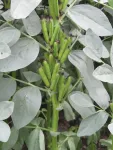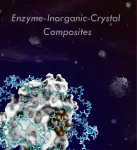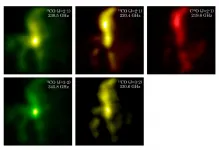(Press-News.org) Faba beans are an excellent source of food protein, but about 4% of the world's population are afflicted by favism, which renders them sensitive to the faba bean anti-nutrients vicine and convicine. Now, an international research team has identified the VC1 gene as responsible for the production of these compounds.
Faba beans have actually been a source of food protein since pre-historic times, but a fraction of the population, mostly from warm southern regions, cannot tolerate them. Pythagoras and his followers avoided them, and Roman priests of Jupiter associated them with death. Today, we know that faba beans produce the anti-nutrients vicine and convicine, which cause a risk for favism - a condition arising from damage to red blood cells - for susceptible individuals.
Among legumes - the pod-producing family of plants to which pea, chickpea and soybean also belong - faba beans have the second-highest yield globally. They also have the highest seed protein content of the starch-containing legumes and out-perform soybean in cool climates. Faba beans are consequently a prime protein source for facilitating a global switch to a plant-based diet, considered necessary for significant reductions in carbon emissions.
The VC1 gene is responsible for vicine-convicine content
However, when people deficient in a specific enzyme eat a large portion of uncooked faba beans, vicine and convicine can induce abnormal breakdown of red blood cells. The resultant hemolytic anemia, known as favism, has inevitably limited the potential use of faba beans. Although there are a number of faba bean varieties with low levels of vicine and convicine, the gene responsible for this trait was previously unknown.
Now, the scientists have identified the gene responsible for vicine-convicine content. What is more, they have identified the specific mutation within this gene that causes the reduction in synthesis. They found that all faba bean varieties with a low vicine-convicine content, descended from a single accession found in a genebank, had two nucleotides - the "letters" that make up DNA - inserted within the VC1 gene. This insertion disrupts the VC1 function and is the only known genetic source of low vicine and convicine content.
Stig U. Andersen, one of project leaders, says, "Working across disciplines to integrate biochemical and molecular genetic data was key to finally unveiling the genetic source of low vicine and convicine."
The work has been published in Nature Plants and it paves the way for the complete description of the biosynthetic pathway of vicine and convicine, and ultimately for breeding, production and commercial use of faba bean varieties totally free from these anti-nutritional compounds.
The team, comprising leading scientists from Denmark, Finland, Germany, the UK and Canada, are already looking to the future. Fernando Geu-Flores, who led the work, says:
"Now that we understand where these anti-nutrients come from, we can attempt to breed them out completely, thus contributing to food safety and sustainability."
INFORMATION:
The project was funded by Innovation Fund Denmark, the Academy of Finland, the UK Biotechnology and Biological Science Research Council, the VILLUM Foundation, the Danish National Research Foundation, Guangzhou Elite and the German Federal Ministry of Food and Agriculture.
Read the article in Nature Plants:
"VC1 catalyses a key step in the biosynthesis of vicine in faba bean" Emilie Björnsdotter, Marcin Nadzieja, Wei Chang, Leandro Escobar-Herrera, Davide Mancinotti, Deepti Angra, Xinxing Xia, Rebecca Tacke, Hamid Khazaei, Christoph Crocoll, Albert Vandenberg, Wolfgang Link, Frederick L. Stoddard, Donal M. O'Sullivan, Jens Stougaard, Alan H. Schulman, Stig U. Andersen, and Fernando Geu-Flores
DOI: https://doi.org/10.1038/s41477-021-00950-w.
You have probably often said to yourself: "This time, I will only buy what I need!" But then you still ended up coming home with things that were not on your shopping list.
How can you prevent such impulse buying? A team from the Chair of Psychology II at Julius-Maximilians-Universität (JMU) Würzburg in Bavaria, Germany, looked at this question. The answer is not that simple, says psychologist Dr Anand Krishna. It depends on what type of person you are: a pleasure-seeker or a person who focuses on security.
Anand Krishna and his JMU colleagues Sophia Ried and Marie Meixner have published ...
The two major challenges in industrial enzymatic catalysis are the limited number of chemical reaction types that are catalyzed by enzymes and the instability of enzymes under harsh conditions in industrial catalysis. Expanding enzyme catalysis to a larger substrate scope and greater variety of chemical reactions and tuning the microenvironment surrounding enzyme molecules to achieve high enzyme performance are urgently needed.
Recently, a research team led by Prof. Jun Ge from Tsinghua University, China reviewed their efforts using the de novo approach to synthesize hybrid enzyme catalysts that can address these two challenges and the structure-function relationship is discussed to reveal ...
A research team at the University of Córdoba has developed and evaluated models for the prediction of solar radiation in nine locations in southern Spain and North Carolina (USA).
Measuring solar radiation is costly, as are all the tasks related to the maintenance and calibration of the most commonly used sensors: pyranometers and radiometers. The result is a paucity of reliable data. Hence, a research group from the University of Córdoba has developed and evaluated several Machine Learning models to predict solar radiation in nine locations (southern Spain and North Carolina, USA) spanning a range of different geo-climatic conditions ...
Washington, DC, July 8, 2021 - A study in the Journal of the American Academy of Child and Adolescent Psychiatry (JAACAP), published by Elsevier, reports that the type of one-on-one treatment plans delivered to toddlers, aged 12-30 months, diagnosed with autism spectrum disorder (ASD) did not lead to any significantly different outcomes. Neither the type of evidence-based intervention provided, nor the number of hours of therapy were shown to have an impact.
The treatments, or intervention methods, delivered by specialized staff to the very young, during the study were either the Early ...
Of the Swedish men in their late teens who performed well in the physical fitness tests for military conscription, a relatively high proportion were able to avoid hospital care when they became infected with COVID-19 during the pandemic up to 50 years later. This has been shown by University of Gothenburg researchers in a register study, with results now published in the BMJ Open.
The study is based on the Swedish Conscription Register, which contains particulars of over 1.5 million young Swedish men who began their military service in the years 1969-2005. Almost all of these men then underwent both a bicycle test and a strength test. Some 2,500 of the men included in the Conscription Register were later, in spring 2020, hospitalized with COVID-19.
For their study, the scientists ...
A research study from the The Lundbeck Foundation Initiative for Integrative Psychiatric Research iPSYCH shows that people with ADHD, who also have another psychiatric diagnosis, are more likely to stop taking their ADHD medicine.
ADHD is one of the most common psychiatric disorders in childhood and is commonly treated with medication. ADHD medicine can be divided into two groups: medicine that has a stimulating effect - also known as stimulants - and non-stimulants, which are often used if a person does not respond well to the other form of medicine.
The medication can be an effective way of reducing symptoms, by ...
Researchers have used the latest wireless technology to develop a new radio receiver for astronomy. The receiver is capable of capturing radio waves at frequencies over a range several times wider than conventional ones, and can detect radio waves emitted by many types of molecules in space at once. This is expected to enable significant progresses in the study of the evolution of the Universe and the mechanisms of star and planet formation.
Interstellar molecular clouds of gas and dust provide the material for stars and planets. Each type of molecule emits radio waves at characteristic frequencies and astronomers have detected emissions from various molecules ...
(Boston)--As analytical instrumentation (gas- and liquid-chromatographs coupled with mass spectrometers) increase in sensitivity and speed, forensic scientists may find themselves still hindered by the process of preparing samples (blood, urine, etc.) for analysis and seeking more efficient approaches.
In an article in WIRES Forensic Science, researchers from Boston University School of Medicine's (BUSM) Biomedical Forensic Sciences program, provide an overview of sample preparation techniques and information on routine sample types that may be encountered in forensic toxicology cases.
Forensic toxicology encompasses a large variety of scenarios including drug-facilitated crimes, understanding ...
A new UBC Sauder School of Business study shows that depending on how employees understand their boss' motivation, employees can feel anger or guilt, and consequently, react differently to abusive supervision.
Former Apple CEO Steve Jobs was a famously harsh corporate leader, one who pushed his employees to extremes to achieve the company's lofty aims.
But while many aspiring leaders still believe that the "tough love" approach is effective, a new study from UBC Sauder shows that, even when abusive leadership is meant to push employees to new heights, it can land them in deep lows in the long term.
Abusive supervision -- which includes behaviours like yelling at employees, giving them the silent treatment, or putting them down in front of their ...
More than a third of coal miners and former coal miners suffering from black lung disease struggle with depression, and more than one in 10 has recently considered suicide, a new study finds.
The study is believed to be the first to examine mental-health issues in a large population of coal miners in the United States. Based on the troubling results, the researchers are calling for more mental health resources and treatment for current and former miners. They also are urging further study of potential contributors to the problem, including social determinants of health, ...




